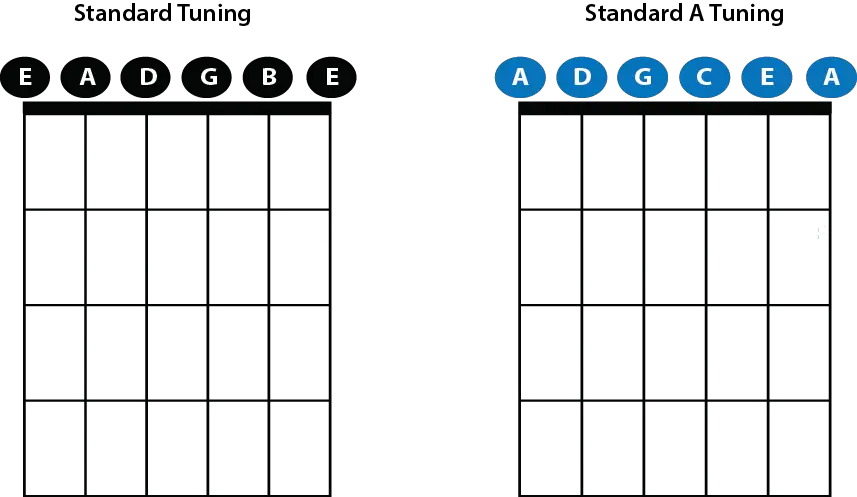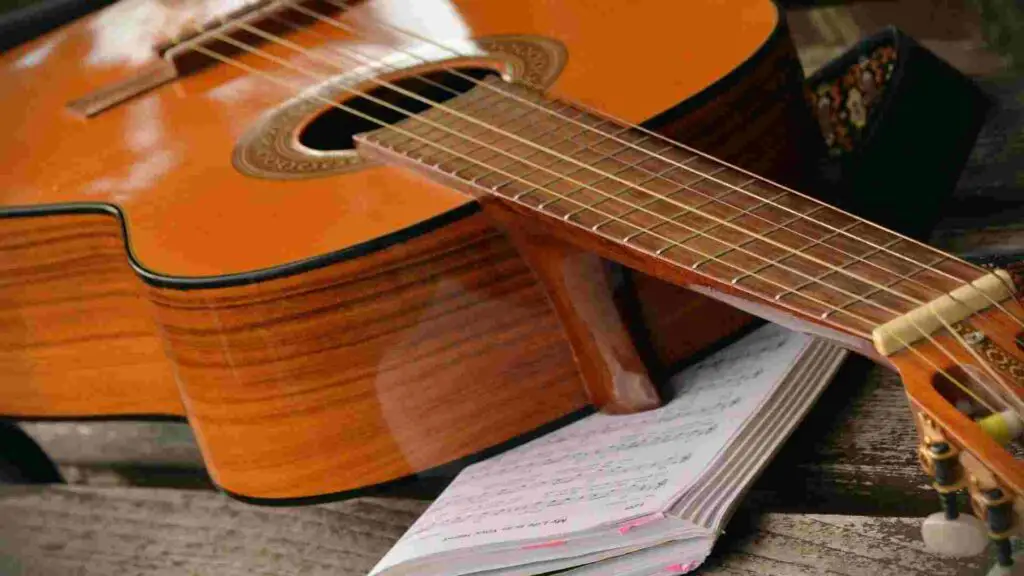In this lesson we’ll go through one of the not so popular guitar tunings, known as A-Tuning or Standard A Tuning.
This guide will show you how to easily tune your guitar to A Standard Tuning, why you should learn this tuning and some songs and bands that use this extremely low guitar tuning.
It’s worth noting that this guide is mainly aimed at people with regular guitars who want to try out Standard A tuning, however, I’ll also briefly explain how to tune to A-Standard tuning if you have a baritone guitar, which is more common.
What is A Standard Tuning?
A Standard Tuning (aka A-tuning) is a type of alternate tuning where all the 6 strings are tuned down a perfect fifth from the standard tuning. This means, to tune your guitar to Standard A tuning, you have to lower each string by 3 and a half steps (a perfect fifth) from the typical Standard tuning.
This tuning is very popular in heavy metal music and other genres like rock, jazz, and fingerstyle. It is also recognized as one of the standard tunings for Baritone guitars besides, Standard B Tuning.
One of the early adopters of this tuning includes the English death metal band, ‘Bolt Thrower’ where they used Standard A tuning for their 1989 album “Realm of Chaos: Slaves to Darkness” using a baritone guitar.
For your reference, the notes below are what a normal (non-baritone) guitar is tuned to when in standard tuning:
E-A-D-G-B-E (lowest to highest)
In Standard A tuning, all 6 strings are lowered by a perfect 5th. Therefore, when a guitar is tuned to Standard A tuning the strings notes are as follows:
A-D-G-C-E-A (lowest to highest)
It’s worth mentioning that for a baritone guitar, the standard tuning is: B-E-A-D-F#-B. And therefore, to tune to A-Standard on a baritone guitar, you only need to tune down each string by one whole step.
Fun fact! Strings 1-4 in Standard A tuning on the guitar are the same notes as a ukulele but an octave lower (2 octaves lower for the 4th string). That’s G-C-E-A. To learn more about ukulele tuning, read this great article from BeginnerUkuleles.com – Ukulele String Notes, Names, and Numbers.
How to Tune to Standard A Tuning
Tuning your guitar from standard tuning to A-Standard tuning is pretty simple. As I’ve mentioned above, all you have to do is tune all the six strings down a perfect fifth – in other words, you need to lower each string by 3-and-a-half steps. Follow the instructions below to tune your guitar down to A-Standard tuning.
Step-By-Step Tuning Guide for Standard A tuning:
- First, tune the 6th (low E) String down a perfect 5th to A
- Then tune the 5th (A) string down a perfect 5th to D
- Similarly, tune the 4th (D) string down a perfect 5th to G
- Tune the 3rd (G) string down a perfect 5th to C
- Then tune the 2nd (B) string down a perfect 5th to E
- Lastly, take the 1st (high E) string and tune it down a perfect 5th to A

So, that’s it. You’re tuned down to Standard A!
Things to keep in mind when tuning to Standard A
- It’s good practice to keep a chromatic tuner handy when tuning the guitar. This will ensure that your new tuning is as accurate as possible.
- In the same vain as above, when you tune your guitar strings down this much, you may find that you have to retune each string multiple times before the guitar settles in tune – especially if you have a floating bridge.
- Make sure you use a heavier gauge string set when tuning to a low tuning like Standard A. This will provide sufficient tension and help to prevent your guitar from going out of tune.
Why Play in Standard A Tuning?
As mentioned above, Standard A tuning involves tuning the strings extremely low (down a 5th) compared to regular standard tuning. This results in producing a much heavier sound, which often works well with a lot of gain and distortion for a really heavy rock or metal guitar sound.
So, if you’re looking to write a heavy riff or you play in a metal band, it could be worth experimenting with Standard A tuning. Also, if you’re a songwriter or producer looking for a rich, deep guitar texture, layering up standard tuned guitars with lower-tuned guitars can produce thicker sounds. It’s common for producers to use baritone guitars in the studio for this very reason. On that note, once you’ve experimented with A-Standard tuning with a regular guitar and you’re digging the sound, I suggest you look into purchasing a baritone guitar, as these instruments are made specifically for these lower tunings.
Songs That Use Standard A Tuning (Mostly on Baritone Guitars)
There are tons of metal songs that use the Standard A tuning, but one of the most popular ones is ‘These Walls‘ by Dream Theater from their 2005 album, ‘Octavarium’.
John Petrucci is known for using a variety of tunings across the band’s discography, and in ‘These Walls’ he perfectly showcases how to put this extremely heavy, Standard A tuning to work.
With some amazing chord voicing, killer riffs, and clean playing, this song is definitely worth a listen (and maybe even a jam?!). Petrucci used his custom “John Petrucci BFR” guitar to record this song, which is a baritone guitar.
Apart from that, Petrucci also used standard A tuning in songs like ‘Blind Faith’ from ‘Six Degrees of Inner Turbulence’ album and ‘Viper King’ from the ‘Distance Over Time’ album.
List of Songs in Standard A Tuning
- Blind by Korn
- Shock by Fear Fcatory
- Descend Into the Eternal Pits of Possession by The Project Hate MCMXCIX
- Sun Of Nihility by A Job for a Cowboy
- Behoid by Born of Osiris
- Realm of Chaos by Bolt Thrower
- The Cry – Demilich




